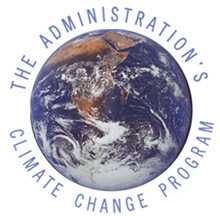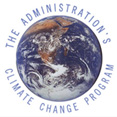 |
 |
ONGOING U.S. DOMESTIC PROGRAMS — INDUSTRY
|
Industry accounts for approximately one-third of U.S. annual carbon
dioxide emissions (and 27 percent of U.S. energy consumption in 1997). A
number of DOE and EPA programs focus on developing and promoting energy
efficient technologies and practices in the nation's most energy-intensive
industries.
• Industries of the Future
This DOE program works cooperatively with the nation's most energy-intensive industries — such as aluminum, glass, chemicals, forest products, mining, petroleum refining, and steel — on research to develop technologies that increase energy and resource efficiency. Together, participating industries use more than 80 percent of all energy consumed in U.S. manufacturing. Promising collaborative efforts include improvements in the process of making steel, pulp and paper, and other energy-intensive products that could dramatically increase efficiency and lower greenhouse as emissions. DOE estimates that participating industries will prevent emissions of more than 25 MMTCE by 2010 and realize $4 billion in energy cost savings.
This EPA program gives technical assistance to more than 530 individual manufacturing companies that have entered into partnership agreements with the Federal government to reduce greenhouse gas emissions, increase productivity, and save money. Companies submit comprehensive action plans that identify specific steps they will undertake between the time they enter into the compact and 2000. By 2010, Climate Wise partners are projected to have avoided cumulative greenhouse gas emissions of nearly 14 MMTCE and saved $2 billion through their participation in the program.
The U.S. government administers a variety of industry-government voluntary partnerships that significantly reduce U.S. methane emissions from a variety of sources: The Landfill Methane Outreach Program, the Coalbed Methane Outreach Program, Natural GasStar, AgSTAR, and the Ruminant Livestock Efficiency Program (RLEP). These programs encourage emissions reductions either through the profitable collection and use of methane, as opposed to its release to the atmosphere, or, in the case of RLEP, through more efficient production in the livestock and dairy sectors. In 1998, participants in the programs reduced methane emissions by almost 5 MMTCE. EPA estimates that investments already made to reduce methane emissions by partners in these programs will reduce cumulative emissions by almost 70 MMTCE and save more than $1 billion. By 2010, EPA expects that methane emissions will be stabilized at 1990 levels as a result of these voluntary partnerships.
EPA Methane and Utility Outreach Programs
Of all greenhouse gases, perfluorocarbons (PFCs), sulfur hexafluoride
(SF6
), and several hydrofluorocarbons (HFCs) are the most potent because of
their extreme stability in the atmosphere and strong absorption of
radiation. PFCs, for example, commonly have atmospheric lifetimes on the
order of thousands of years. The U.S. government administers a variety of
industry-government voluntary partner-ships that are reducing emissions of
those gases substantially. The Voluntary Aluminum Industrial
Partnership
(VAIP) works with 11 of the nation's 12 primary aluminum producers
to
reduce PFC emissions while increasing the efficiency of primary aluminum
production. The Federal government also administers a regulatory program
through the Clean Air Act to help direct industry toward safe, new
alternatives as manufacturers consider substitutes for ozone-depleting
chlorofluorocarbons (CFCs) and halon compounds.
Investments already made by partners in voluntary programs will reduce
cumulative emissions by more than 49 MMTCE over the lifetime of the
projects. In addition, an estimated 54 MMTCE will have been prevented by
2000 through regulation. HFC and PFC emissions in applications to replace
ozone-depleting substances are expected to be significantly below
business- as-usual scenarios due to voluntary and regulatory initiatives.
HFC, PFC and SF6 emissions from other industrial sources are expected to
be at or below 1990 levels by 2010.
DOE is developing new industrial combined heat and power (CHP) systems to
capture thermal heat that otherwise would be wasted. CHP systems are
expected to be 15 percent more energy efficient and 80 percent cleaner
than conventional power systems and cut electricity costs by 10 percent.
In addition, EPA and DOE are working to eliminate barriers to the rapid
dissemination of combined heat and power technology.
Motor Challenge, Steam Challenge, Combined Heat and Power Challenge, and
Compressed Air Challenge are a group of voluntary initiatives aimed at
improving energy efficiency in U.S. manufacturing plants by breaking down
market barriers to the development and diffusion of energy efficient
technologies and practices. These four Federal pro-grams offer industry a
variety of technical assistance, tools, and information. By 2015, these
initiatives are expected to reduce emissions by approximately 20 MMTCE and
generate $3 billion in annual cost savings.
WasteWi$e works with U.S. businesses; Federal, state, local, and tribal
government agencies; and other institutions to reduce municipal solid
waste. Presently, more than 900 organizations are WasteWi$e partners.
Waste reduction activities reduce greenhouse gas emissions in several
ways, including energy savings, increased carbon sequestration, and
avoided methane emissions. In 1998 alone, the combined waste reduction
results of WasteWi$e partners prevented emissions of approximately 4.5
MMTCE — equal to the average annual emissions from electric power
consumption from roughly 2.7 million households.
|

![]()